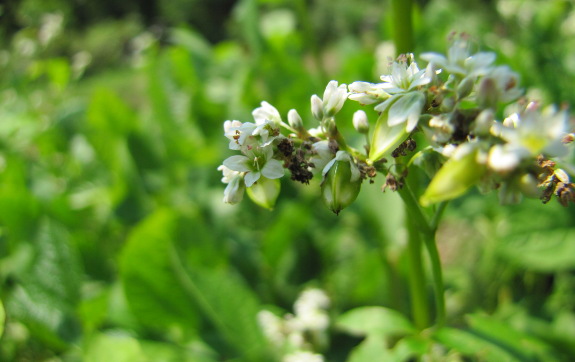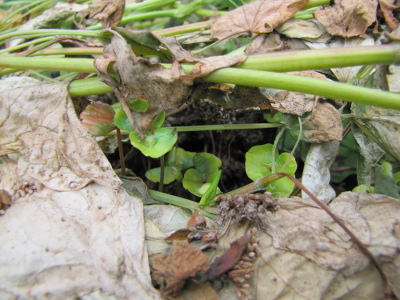
Back to back summer cover crops

So you took my advice
and planted buckwheat and/or cowpeas as a quick
summer cover crop,
but you've actually got a longer fallow window than the cover crops
need. Once you start to see tiny fruits forming on the cover
crops (like the green triangles in the photo above), it's time to get
them out of there so that they don't set seeds and become a weed
problem.
 Why not toss another round of
summer cover crop seeds on the ground before cutting, then let the
first cover crop act as a light mulch to promote germination of the
later planting? I tried out this method a week ago, and little
buckwheat seedlings are already poking up through the debris.
I'll let you know how solid of a stand I end up with, but if this
planting method works, it's definitely the easiest way of getting
summer cover crops established.
Why not toss another round of
summer cover crop seeds on the ground before cutting, then let the
first cover crop act as a light mulch to promote germination of the
later planting? I tried out this method a week ago, and little
buckwheat seedlings are already poking up through the debris.
I'll let you know how solid of a stand I end up with, but if this
planting method works, it's definitely the easiest way of getting
summer cover crops established.
Want more in-depth information? Browse through our books.
Or explore more posts by date or by subject.
About us: Anna Hess and Mark Hamilton spent over a decade living self-sufficiently in the mountains of Virginia before moving north to start over from scratch in the foothills of Ohio. They've experimented with permaculture, no-till gardening, trailersteading, home-based microbusinesses and much more, writing about their adventures in both blogs and books.
Want to be notified when new comments are posted on this page? Click on the RSS button after you add a comment to subscribe to the comment feed, or simply check the box beside "email replies to me" while writing your comment.

I've considered this, but there seem to be two reasons to cut and replant instead. First, as a plant ages past the bloom stage, there's a lot more carbon for every part nitrogen --- the plant gets woody. That means that you have to wait longer between when you cut your crop and when it has rotted enough to be planted into. For winter cover crops, that's no problem since I want them to be mulches, but my summer cover crops are supposed to melt into the ground and provide immediate fertility.
The other problem is that if you let your cover crops go to seed, the seeds may or may not sprout right away. Some of them are bound to stick around and sprout in next year's garden. This isn't such a big worry with summer cover crops like buckwheat and cowpeas since they're so easy to pull out, but I'd be leery with heavier rooted cover crops.